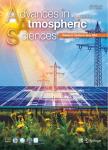The Dynamic Plateau Monsoon Index and Its Association with General Circulation Anomalies
The Dynamic Plateau Monsoon Index and Its Association with General Circulation Anomalies作者机构:Key Laboratory of Land Surface Process and Climate Change in Cold and Arid RegionsCold and Arid Regions Environmental and Engineering Research InstituteChinese Academy of Sciences Inner Mongolia Autonomous Region Meteorological Observatory Institute of Tibetan Plateau ResearchChinese Academy of Sciences
出 版 物:《Advances in Atmospheric Sciences》 (大气科学进展(英文版))
年 卷 期:2012年第29卷第6期
页 面:1249-1263页
核心收录:
学科分类:07[理学] 070601[理学-气象学] 0706[理学-大气科学]
基 金:supported by the National Basic Research Program of China(Grant Nos. 2010CB951701 and 2012CB026101) the National Natural Science Foundation of China(Grant Nos.41175068, 40875005 and 40810059006) the Knowledge Innovation Program of the Chinese Academy of Sciences(Grant No.KZCX2-YW-Q11-01) the Gansu Key Science and Technology Program(Grant No.1001JKDA001) the European Commission(Call FP7-ENV-2007-1,Grant No. 212921)
主 题:Qinghai-Xizang Plateau Dynamic Plateau Monsoon Index center position general circulation
摘 要:Based on monthly ECMWF reanalysis-Interim (ERA-Interim) reanalysis data, along with monthly precipitation and temperature data, the Dynamic Plateau Monsoon Index (DPMI) is defined. The results of a contrast analysis of the DPMI versus the Traditional Plateau Monsoon Index (TPMI) are described. The response of general circulation to northern Qinghai-Xizang Plateau summer monsoon anomalies and the correlation of the DPMI with general circulation anomalies are investigated. The results show that, the DPMI reflected meteorological elements better and depicted climate variation more accurately than the TPMI. In years when the plateau summer monsoon is strong, the low over the plateau and the trough near the eastern coast of Asia are deeper and higher than normal over South China. This correlation corresponds to two anomalous cyclones over the plateau and the eastern coast of Asia and an anomalous anticyclone in South China. The plateau and its adjacent regions are affected by anomalous southwesterly winds that transport more moisture to South China and cause more precipitation. The lower reaches of the Yangtze River appear to receive more precipitation by means of the strong westerly water vapor flow transported from the "large triangle affecting the region". In years when the plateau summer monsoon is weak, these are opposite. The plateau monsoon is closely related to the intensity and position of the South Asian high, and the existence of a teleconnection pattern in the mid-upper levels suggests a possible linkage of the East Asian monsoon and the Indian monsoon to the plateau summer monsoon.



